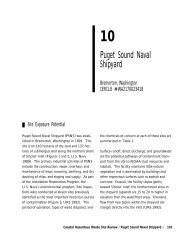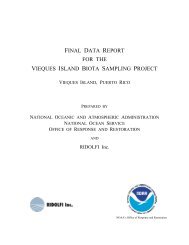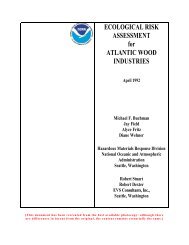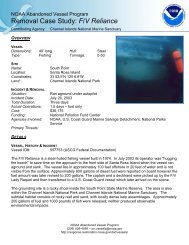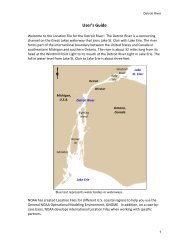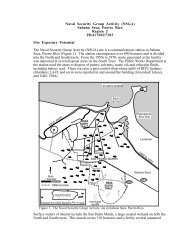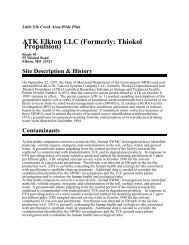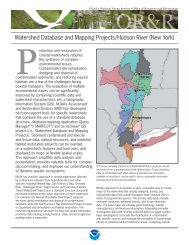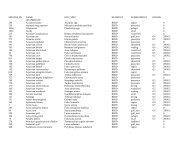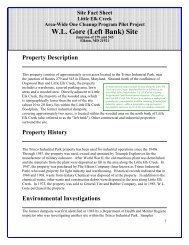Andrews Air Force Base - NOAA's Ocean Service Office of ...
Andrews Air Force Base - NOAA's Ocean Service Office of ...
Andrews Air Force Base - NOAA's Ocean Service Office of ...
Create successful ePaper yourself
Turn your PDF publications into a flip-book with our unique Google optimized e-Paper software.
30 EPA Region 3<br />
Site-Related Contamination<br />
A variety <strong>of</strong> investigations have been conducted at the three landfills <strong>of</strong> concern. For a groundwater<br />
contamination survey conducted in 1991, nine to 11 groundwater samples were collected from<br />
monitoring wells at each <strong>of</strong> the three landfills (Dames and Moore 1992a). For remedial investigations<br />
in 1992 and 1993, four to six soil samples and two to three surface water and sediment<br />
samples were collected at each <strong>of</strong> the three landfills (Dames and Moore 1992b; Dames and Moore<br />
1992c; Dames and Moore 1993). For an additional remedial investigation in 1995 at LF05, six surface<br />
soil samples, 43 subsurface soil samples, and four sediment samples were collected, as well as<br />
five groundwater samples from monitoring wells (EA Engineering 1996). In 1993, four paired sets<br />
<strong>of</strong> surface water and sediment samples were collected from Piscataway Creek to assess potential<br />
impacts on the creek from the landfills (USAF 1993).<br />
Table 3 summarizes maximum concentrations <strong>of</strong> contaminants detected in soil and groundwater<br />
from the landfills and in sediment and surface water from landfill locations or from Piscataway<br />
Creek in the vicinity <strong>of</strong> the landfills.<br />
The soil data indicate a source <strong>of</strong> trace element (metals) contamination when maximum detected<br />
concentrations are compared to soil screening guidelines. Arsenic, chromium, and copper<br />
exceeded the soil screening guidelines by less than an order <strong>of</strong> magnitude. Lead, mercury, nickel,<br />
and zinc exceeded by one order <strong>of</strong> magnitude. No soil screening guidelines are available for comparison<br />
to the maximum concentrations <strong>of</strong> cadmium and silver in soil. The presence <strong>of</strong> polynuclear<br />
aromatic hydrocarbons (PAHs), polychlorinated biphenyls (PCBs), and pesticides also indicate<br />
a source <strong>of</strong> contamination. There are no soil screening guidelines available for comparison to the<br />
maximum concentrations <strong>of</strong> those contaminants.<br />
Groundwater samples contained trace elements and several pesticides. Trace elements detected<br />
in groundwater at maximum concentrations that exceeded the applicable ambient water quality<br />
criteria (AWQC) by one order <strong>of</strong> magnitude were cadmium and silver. Lead, nickel, and zinc<br />
exceeded by less than an order <strong>of</strong> magnitude. Maximum concentrations <strong>of</strong> arsenic, chromium,<br />
copper, and mercury did not exceed their AWQCs. Four pesticides were detected in groundwater.<br />
Chlordane exceeded its AWQC by two orders <strong>of</strong> magnitude; endrin aldehyde by one order <strong>of</strong> magnitude;<br />
dieldrin by less than an order <strong>of</strong> magnitude; and the maximum concentration <strong>of</strong> DDD did<br />
not exceed the AWQC. PAHs and PCBs were not detected.<br />
In surface water from Piscataway Creek, concentrations <strong>of</strong> cadmium, copper, lead, and zinc<br />
exceeded their respective freshwater AWQCs by less than an order <strong>of</strong> magnitude. Maximum concentrations<br />
<strong>of</strong> arsenic, chromium, and nickel did not exceed their AWQCs. Mercury and silver were<br />
not detected. The only organic compound detected in surface water from Piscataway Creek was<br />
dieldrin, but its concentration did not exceed the AWQC.<br />
In sediment, arsenic, cadmium, lead, mercury, nickel, silver, and zinc were detected at maximum<br />
concentrations that exceeded their respective threshold effect levels (TELs) by less than an order<br />
<strong>of</strong> magnitude. Chromium and copper were also detected, but at concentrations less than their<br />
TELs. In addition, concentrations <strong>of</strong> PCBs, total PAHs, and three pesticides exceeded TELs by less<br />
than an order <strong>of</strong> magnitude. The highest concentration <strong>of</strong> PAHs in sediment was detected in a<br />
sample collected from Piscataway Creek between LF06 and LF07.




